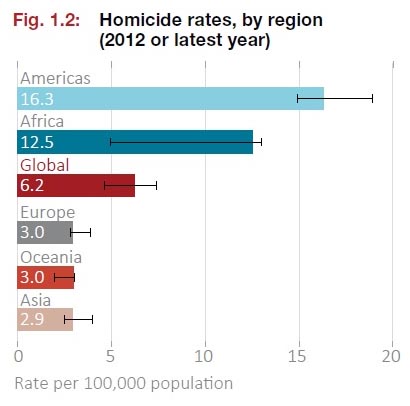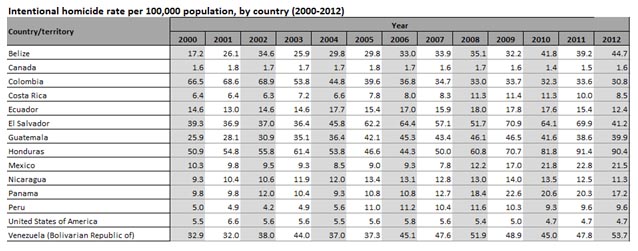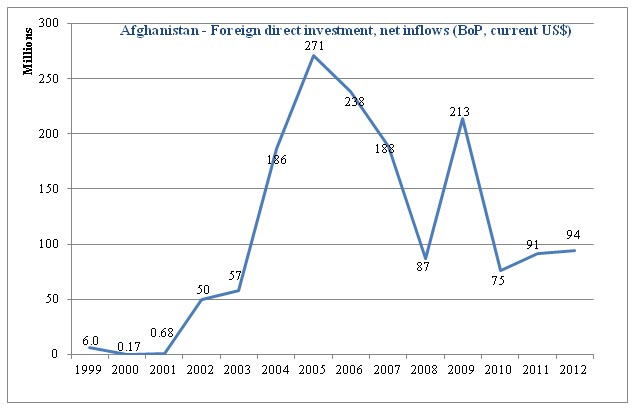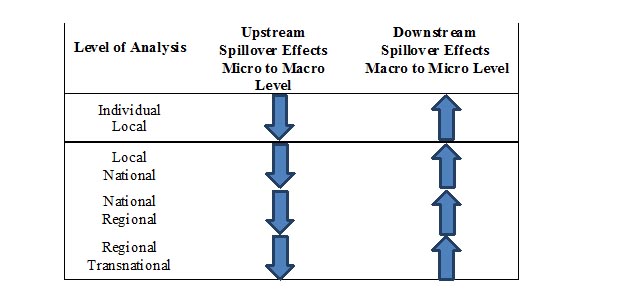Criminal Groups: Multifarious Threats to State Security, Regional Stability and Individual Wellbeing
Irina Alexandra Chindea and Byron Ramirez
Criminal organizations present unique challenges to individual, national, regional and international security. Most of them are complex entities with impact beyond the economic realm. In addition to having access to vast financial capital to fund their operations, an increasingly high number of criminal organizations also possess political reach and exert profound influence on local, national, and regional affairs. Over time, such organized criminal groups have expanded their respective networks and have employed technology in novel and startling ways to counteract law enforcement and military efforts to detect, disrupt, and capture them.
In this context, throughout a series of three individual essays, we aim to re-open the dialogue on the different types of threats criminal groups yield across various levels of analysis as well as the responses they generate from the main actors and stakeholders at each level. In this vein, our first essay opens the series by providing a brief introduction to the issue of organized criminality, and it succinctly introduces the alternative conceptual framework that we propose for the analysis of the threats emanating from criminal groups. Our second essay develops in detail the major threats present at each level of the framework, their impact, and “upstream” and “downstream” spillover effects. In the third follow-up essay we analyze the responses and reactions these criminal threats generate at the community, state, regional and international levels, particularly in light of the apparently limited responses from governments in the Western Hemisphere, which is one of the world’s regions most affected by the activities of these criminal organizations (graph 1).
Graph 1: Homicide Rates by Region as presented in UNODC’s 2013 Global Study on Homicide

Source: UNODC Homicide Statistics (2013).[1]
The Significance of the Challenges Posed by Organized Criminal Groups
Since the 9/11 attacks the United States Government has focused mostly on thwarting terrorist cells, and limiting terrorists’ capacity to operate and launch future attacks against American targets. Furthermore, military operations in far-away countries such as Iraq and Afghanistan have been the policy makers’ focal point for several years, while relatively lower consideration has been given to activities taking place closer to home and in America’s inner-cities. Nevertheless, a select group of scholars and practitioners have warned about the rising threat posed by criminal organizations,[2] specifically the Mexican cartels,[3] Colombian bandas criminales (criminal gangs),[4] and Central American gangs such as the Maras,[5] all of which have seen a rise in profile over the past few years.
At the same time, despite these scholars’ warnings and the rising criminality and violence in the Western hemisphere (table 1) policymakers seem to have responded with a certain degree of delay and meager funding. For several years, Washington has been primarily engaged in pursuing and disrupting terrorist activities at home and abroad, and inadvertently the policy sphere has not proposed a robust response and set of counter-measures designed to combatting criminal organizations to the degree such a threat requires. Moreover, as a lot of attention and resources have been directed into fighting and studying terrorism, the activities of criminal groups have remained relegated to understaffed and underfunded law enforcement agencies. This situation has allowed these groups to flourish, diversify their activities and extend the reach of their operations to a global scale.
Table 1: Evolution of Intentional Homicide Rates in the Western Hemisphere 2000-2012

Source: Data from UNODC. Table prepared by the authors
Besides the increase in intentional homicide rates in many countries across the Western Hemisphere, the importance of the challenge many governments in the region face is related to the gruesomeness of the violence and the extent to which it has spread across national borders. Decapitations and the dismemberment of dead bodies in Mexico, and the spread of Mexican cartels’ illicit activities deep into South America and Canada are cases in point. In addition to the increase in intensity and savagery of the violence, certain criminal groups have become highly sophisticated when it comes to financial transactions and money laundering operations.
This aspect is not solely the result of the increasingly free flow of financial capital across borders, but also of the rise in information technologies and higher Internet adoption and usage rates. The more adept use of information technologies has allowed these groups to make good use of the anonymity provided by cyber-space, which has translated into a higher degree of freedom in conducting illicit activities. In addition, it facilitated the transnational movement of financial capital, and the subsequent laundering of illicit proceeds. In this way, the increasing interrelatedness of violence and illicit activities on the ground along with financial and cyber-crimes present additional conundrums to the various governments in the region facing the challenge of rising organized criminality.
Organized Criminality: A Long-Enduring and Wide-Reaching Challenge
Just like terrorist acts that have a long history and date back to – at least – the attacks mounted by Jewish zealots against the Roman occupation, organized criminal activity is not a new phenomenon. Organized criminality – under various guises – has been around for many centuries despite the lack of heightened public awareness in the absence of an event of catastrophic proportions such as 9/11.
The extent, integration and trans-nationalization of criminal activities have fluctuated over time commensurate with the degree of trade and of licit economic activity taking place across countries. Often times, as economic integration and transnational licit economic activities have wavered, so too has international criminal activity. At the height of the Ottoman Empire, as well as in the second half of the 19th century and pre-World War I period, with the expansion of intra-empire transactions and with the first wave of globalization, illicit criminal activities followed the trend set by licit economic exchanges while negatively correlating with the degree of regulation of such economic transactions. With the end of the Cold War, alongside the liberalization of markets and economies, a second wave of globalization emerged leading to an upswing in transnational criminal activities.
Organized criminality can take the form of mafia organizations, drug trafficking organizations, street gangs, prostitution rings, et al. In Latin America, drug cartels represent the main form of organized criminality. Their emergence and increased strength throughout the region over the past 40 years should not come as a surprise. In Latin America as well as in other areas of the world, several factors including globalization, weak States, poor rule of law, corruption, and economic inequality converged and created conditions that facilitated the emergence of criminal organizations. This conjunction of influences has in some cases led to the subsequent rise of illegal drug trafficking, often times as an alternative means of economic survival for many of those involved.
In the recent decade though, the drug cartels have morphed into more complex entities moving beyond the simple traffic of illicit substances. If in the past various criminal groups or cartels were focusing their operations on the production, transportation and distribution of only one specific illicit substance, many of today’s organizations are “polydrug” entities trafficking in a wide range of illicit drugs instead of just one. Also, many cartels have diversified the portfolio of their operations beyond drug trafficking, and started to engage in a variety of other unlawful activities such as extortion; kidnappings; smuggling of humans across borders; trafficking in humans, organs,[6] protected and endangered species; illegal logging; waste dumping.[7]
Traditionally, the threats organized criminality poses have been addressed from a law enforcement perspective in a manner that resembles the approach to terrorism before 9/11, when it was elevated to a threat to international security.
In the current security environment though, the traditional law enforcement approach may prove wanting and unable to cope with the evolution of criminal organizations and the complexity of their respective threats. At this juncture, the natural question to ask is: “What are the actual threats that organized crime produces and at what level?” Empirical accounts of the activities of criminal groups worldwide attest to their posing of military threats when given access to advanced weaponry that can be used to engage against national military forces. They also represent threats to local governance structures, the rule of law, the strength and stability of institutions, culture (e.g., the entrenchment of narco-culture in Mexican society with its subsequent ills), and the disruption of domestic infrastructure (e.g., oil pipelines, waterways, road blockades).
Moreover, in developing nations the activities of criminal groups may delay or even impede economic development by fostering an environment of heightened insecurity with low levels of political stability that quite often translate into unstable foreign direct investment and other malfunctions of the economic market. For instance, graph 2 below illustrates the volatility of foreign direct investment into Afghanistan from 1999 to 2012. The country is the world’s largest opium producer[8] and, since 2001, the country’s Taliban insurgency has relied heavily on drug trafficking and the taxation of opium trade as one of its main sources of revenues.[9] Together with the financing received from various actors in Pakistan and Gulf countries, it allowed the conflict with the NATO forces on the ground to become protracted, and translated into a volatile environment for foreign investors with an interest in the country. Similarly, the drug-cartel related violence in Mexico has had a negative impact on foreign direct investment[10] as well as on GDP, consumption and productive investment in the states most affected by violence.[11]
Graph 2: Evolution of Foreign Direct Investment in Afghanistan

Source: Graph prepared by the authors based on data provided by the World Bank.
As the examples above illustrate, the activities of organized criminal groups have recently become increasingly diversified and have a wide reach across the globe. Irrespective though of where they take place in the world, their illicit activities have deep, negative consequences for state capacity and a destabilizing effect on society.
Overview of the Threat Analysis Framework
In this environment, we argue that organized criminality, irrespective of the type of activity on which it focuses - alcohol, illicit drugs, other illicit substances, human trafficking, et al - makes its presence felt across five main levels of analysis:
1. Individual level
2. Local level
3. National level
4. Regional level
5. Transnational and International level
The activities of organized criminal groups pose threats that manifest themselves across each of the five levels presented above, and each level is accompanied by a separate set of consequences, reactions and responses. We contend that ultimately these five levels are inter-related, and spill into each other progressively and bi-directionally at various degrees from country to country. In this context, actions undertaken at lower levels – such as the individual and local – are having an upstream influence on higher levels such as the state and regional level. Furthermore, spillover effects also gravitate downstream from the macro-level back into the micro-level. For instance, the transnational illicit activities in which the groups engage have an influence on the well-being of individual actors as well as on the decisions taken by criminal actors who operate at the regional, state and community levels. Table 2 below briefly depicts the upstream and downstream “flow” of spillover effects of criminal activities as well as the spillover of the responses these activities engender at each level.
Table 2: Interrelated Upstream and Downstream Spillover Effects

The threats criminal groups pose across these five levels of analysis generate bi-directional, mirror-reactions and policy responses on the part of individuals, communities, the state, regional and international organizations charged with countering the activities of organized crime. Threats at the individual level will generate upstream reactions and responses at the individual and community levels that are likely to have an impact on state level policies against organized criminality. In reverse, state level policies geared towards combating organized crime will definitely have a downstream impact on the decisions and actions that take place at the local and individual levels.
As the discussion above implies, on the one hand, criminal groups pose threats across five different levels of analysis, while, on the other, they produce responses from the main stakeholders present at each level. In table 3 below we present a synthesis of the analytical framework that we propose for the former, and which brings to the fore the type of threat criminal groups pose, the unit affected (or which they target), together with the impact their activities are likely to have on this unit or target. The policy responses and reactions at the level of communities affected represent the core of a separate essay, the third one in this series.
Table 3: Overview of Threat Analysis Framework

Conclusion
Over time, criminal organizations have learned to adapt to an ever-changing environment. They have become more resourceful and strategic gaining access to massive financial wealth and political influence. Additionally, they have taken hold of worldwide distribution networks, and utilized advanced technology to meet the needs of their illicit activities. Given their increasing sophistication and diversified portfolio of activities, criminal organizations generate a series of significant, dynamic challenges that must be thwarted and addressed by policymakers. Owing to the various reasons outlined in this essay, it is an utmost priority that governments and security agencies re-evaluate the threats that emanate from criminal organizations across various levels of analysis.
Moreover, transnational organized criminality threatens state capacity and international security. In our second essay we provide an in-depth discussion of the specific threats and spillover effects posed by organized criminality which have been briefly outlined in the previous table. In our third and final essay of this series, we analyze the responses and reactions these criminal threats generate at the community, state, regional and international levels.
End Notes
[1] Global Study on Homicide 2013, UNODC Report, page 22. Report available at http://www.unodc.org/documents/gsh/pdfs/2014_GLOBAL_HOMICIDE_BOOK_web.pdf. According to the report “The bars represent population-weighted homicide rates based on the source selected at the country level, with low and high estimates derived from homicide rates based on additional sources existing at the country level.”
[2] Williams, Phil. “Transnational Criminal Organisations and International Security.” Survival 36,
no. 1 (1994). 96–113; Robert J. Bunker and John P. Sullivan, “Cartel Evolution: Potentials and Consequences,” Transnational Organized Crime, Vol. 4, No. 2, Summer 1998.
[3] Bunker, Robert J. “Strategic Threat: Narcos and Narcotics Overview.” Small Wars & Insurgencies 21, no. 1 (2010): 8-29.
[4] Prieto, Carlos Andres, Bandas Criminales En Colombia: ¿Amenaza a La Seguridad Regional? (Criminal Gangs: A Threat to Regional Security?) (January 30, 2014). OPERA No. 12, 2012. Available at SSRN: http://ssrn.com/abstract=2388190; “Neo-Paramilitary Gangs Ratchet Up Their Threat to Colombian Civil Society and the Long Term Survival of Civic Rectitude in the Public Arena,” COHA Research Associates Denise Fonseca and Candiss Shumate, November 17, 2011.
[5] Arana, Ana. “How the Street Gangs Took Central America.” Foreign Affairs. 1 May 2005. http://www.foreignaffairs.com/articles/60803/ana-arana/how-the-street-gangstook-central-america; Sullivan, John P. “Maras Morphing: Revisiting Third Generation Gangs.” Global Crime 7, no. 3-4 (2006): 487-504.
[6] “Have the Knights Templar Diversified into Organ Trafficking?,” by Michael Lohmuller, Insight Crime, March 18, 2014, http://www.insightcrime.org/news-briefs/have-the-knight-templar-diversified-into-organ-trafficking
[7] “The Global Regime for Transnational Crime,” Council on Foreign Relations, June 25, 2013, http://www.cfr.org/transnational-crime/global-regime-transnational-crime/p28656?cid=rss-economics-the_global_regime_for_transnat-070212
[8] “Afghan opium fuels ‘global chaos’,” BBC News, October 21, 2009, http://news.bbc.co.uk/2/hi/south_asia/8319249.stm
[9] “Afghan opium production on the rise despite U.S. troops, inspector says,” NBC News, January 15, 2014, http://worldnews.nbcnews.com/_news/2014/01/15/22316414-afghan-opium-production-on-the-rise-despite-us-troops-inspector-says?lite
[10] “Mexico Businesses Fleeing Violence Creates Economic Disparity,” by Michael Lohmuller, Insight Crime, February 27, 2014, http://www.insightcrime.org/news-briefs/mexico-businesses-fleeing-violence-creates-economic-disparity
[11] “The Economic Consequences of the Mexican Drug War,” by Jose R. Balmori de la Miyar, unpublished mimeo Cornell University, February 2, 2014, http://www.human.cornell.edu/pam/academics/phd/upload/growth.pdf
